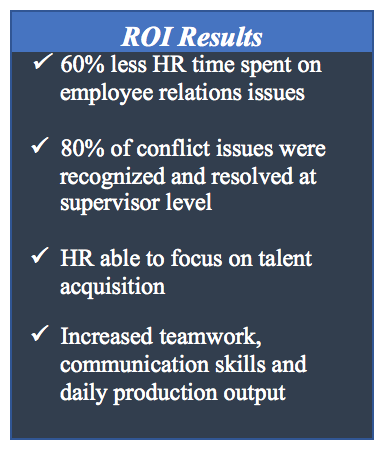Intercultural Awareness Case Study: How One Organization Improved Employee Relations
Written by: Allison Bowers and Michelle Miller
Challenge
The human resources department of a mid-sized American manufacturing/assembly company was spending 80% of its time addressing employee relations concerns instead of focusing on a key initiative, talent acquisition.
Background
Upon meeting with the Human Resource Manager and conducting a needs assessment, Central Piedmont Community College (CPCC) learned that challenges were centered on shop floor employee communication and misunderstandings as it related to both verbal and non-verbal communication. Furthermore, the first level supervisors were not equipped to be able to recognize and address these concerns with their direct reports; therefore, issues were escalated to the human resources department. Conflict management became a main focus of human resource’s priorities rather than the recruiting function. During discussions, it was revealed that the employee population on the production floor represented 19 different countries and there had not been any type of cultural orientation for the employees.
Solution
CPCC recommended a two-pronged approach which consisted of cultural and competency-based training for the supervisors as well as cultural awareness training for the shop floor personnel. A concentrated effort was spent identifying two racially and gender-diverse instructors to design and deliver a course to address the communication and cultural challenges. The design phase included meeting with human resources and senior management to ensure an understanding of existing company culture and the alignment of training to the organization’s objectives, observation time on the production floor, interaction with production employees, and research. An interactive course was designed to integrate each country represented by the employee population and various activities were built in. A member of human resources was present at the start of each class and all supervisors attended a pilot class so that they would be familiar with the content and could provide initial feedback. No supervisors were present in the shop floor personnel training sessions so that participants would feel relaxed and comfortable to share their thoughts and challenges.
The four-hour course was co-facilitated and delivered on-site at the company. Participants in the course had the opportunity to share with their peers their home country, a detail about themselves, and the greatest challenge in working with others. This was done via whiteboard incorporating the use of drawing/pictures to enhance the effectiveness of communication and overcome language barriers.
Example of outcome:
|
Country of origin: |
Something about me: |
Greatest challenge in working with others: |
|
United States |
Like to talk a lot |
Dry sense of humor – others don’t know how to relate |
Additional activities included an exercise in country recognition utilizing the country’s flag and another employing the use of historical/cultural clues and preference selections where simple items were shown (car vs. truck) and participants explained their choice and reasoning. This provided the employees the opportunity to see not only differences, but similarities amongst themselves.
The session concluded with a reflection on building relationships and each participant was asked three key questions so that a personal commitment plan could be identified and acted upon:
- How do you communicate better?
- How do you learn more about your coworkers?
- How can you share more about yourself?
The instructors shared that “by the end of the session, everyone walked away with an appreciation of others’ country and customs. Also, there was a dramatic change in how one person accepted the other and people became more comfortable and relaxed communicating with and amongst each other. A Nepali and American worked side by side for one year and never said a word to each other until this training was delivered to the employees.”
At the end of the course participants were able to:
- Describe how they are similar and how they are different from other employees;
- Describe how these likenesses and differences add value to the overall team performance;
- Apply techniques to learn about and establish trust with other employees; and
- Utilize learning to apply to a real situation.
In addition to the cultural training, the supervisors also attended a series of classes to build their knowledge and competency in the areas of leadership, conflict resolution, communication, teambuilding and managing change.
Results
After several months of training over 250 production employees as well as the supervisors, CPCC revisited the employer to determine what changes had occurred, what challenges were currently being faced, and how the training had impacted the organization. First-line supervisors are more comfortable in recognizing conflict issues and 80% of issues were resolved with limited or no involvement from human resources. According to HR, supervisors are demonstrating a higher confidence level with the ability to recognize conflict situations before escalating, initiating conversations, practicing good listening skills and determining solutions. The company invested in whiteboards in the production area so that employees can use them to draw and communicate with each other if they are having complications in expressing the message that they are trying to convey. In addition, daily production goals are being met and a noticeable improvement of teamwork and communication among the team members is recognizable. Human Resources was able to spend 70% of their time, versus 20%, on their key initiative of talent acquisition.
Useful Resource:
Kansas University Work Group for Community Health and Development. (2015). Chapter 27, Section 7: Building Culturally Competent Organizations. Lawrence, KS: University of Kansas. 30 June 2016. Web. <http://ctb.ku.edu/en/table-of-contents/culture/cultural-competence/culturally-competent-organizations/main>.

